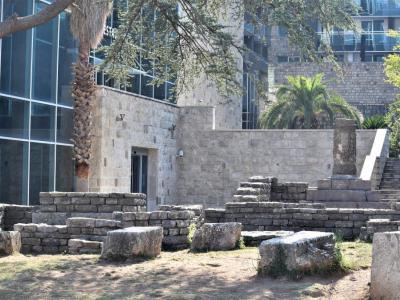
Ruins of Roman-era Necropolis, Budva
The Ruins of the Roman-era Necropolis in Budva, Montenegro, offer a fascinating journey back in time to the Hellenic and Roman periods. The origins of this remarkable necropolis are intertwined with the construction of the "Avala" hotel, which took place between 1936 and 1938. During this process, archaeologists uncovered a treasure trove of historical artifacts and graves.
The necropolis is divided into two distinct periods. The older section dates back to the Hellenic period, spanning from the 4th to the 1st centuries BC, while the newer portion belongs to the Roman era, ranging from the 1st to the 2nd centuries AD. These two periods provide a glimpse into the changing civilizations that once thrived in this region.
It is estimated that the necropolis served its purpose for over a millennium, bearing witness to the passing of countless generations. Its longevity underscores its historical significance.
The excavation yielded a wealth of artifacts, including gold and silver jewelry, various types of dishes, glassware, ceramics, and even weapons. These precious items provide valuable insights into the daily lives and customs of the ancient inhabitants.
The majority of the discovered artifacts, including precious gold and silver jewelry, ancient coins, pottery vessels, and various metal items like weapons, are currently showcased at the Budva City Museum for public viewing and appreciation.
The necropolis is divided into two distinct periods. The older section dates back to the Hellenic period, spanning from the 4th to the 1st centuries BC, while the newer portion belongs to the Roman era, ranging from the 1st to the 2nd centuries AD. These two periods provide a glimpse into the changing civilizations that once thrived in this region.
It is estimated that the necropolis served its purpose for over a millennium, bearing witness to the passing of countless generations. Its longevity underscores its historical significance.
The excavation yielded a wealth of artifacts, including gold and silver jewelry, various types of dishes, glassware, ceramics, and even weapons. These precious items provide valuable insights into the daily lives and customs of the ancient inhabitants.
The majority of the discovered artifacts, including precious gold and silver jewelry, ancient coins, pottery vessels, and various metal items like weapons, are currently showcased at the Budva City Museum for public viewing and appreciation.
Want to visit this sight? Check out these Self-Guided Walking Tours in Budva. Alternatively, you can download the mobile app "GPSmyCity: Walks in 1K+ Cities" from Apple App Store or Google Play Store. The app turns your mobile device to a personal tour guide and it works offline, so no data plan is needed when traveling abroad.
Ruins of Roman-era Necropolis on Map






Sight Name: Ruins of Roman-era Necropolis
Sight Location: Budva, Montenegro (See walking tours in Budva)
Sight Type: Attraction/Landmark
Guide(s) Containing This Sight:
Sight Location: Budva, Montenegro (See walking tours in Budva)
Sight Type: Attraction/Landmark
Guide(s) Containing This Sight:
Walking Tours in Budva, Montenegro
Create Your Own Walk in Budva
Creating your own self-guided walk in Budva is easy and fun. Choose the city attractions that you want to see and a walk route map will be created just for you. You can even set your hotel as the start point of the walk.
Budva Introduction Walking Tour
Nestled along one of Europe’s most beautiful coastlines, Budva, without doubt, is one of the tourist capitals of Montenegro.
The name "Budva" (or Budua in Italian) carries echoes of the town's ancient past and is believed to have originated from the Illyrian word "Buthos," meaning ox. Dating back to the 5th century BC, the town was originally part of Illyria and later... view more
Tour Duration: 2 Hour(s)
Travel Distance: 1.3 Km or 0.8 Miles
The name "Budva" (or Budua in Italian) carries echoes of the town's ancient past and is believed to have originated from the Illyrian word "Buthos," meaning ox. Dating back to the 5th century BC, the town was originally part of Illyria and later... view more
Tour Duration: 2 Hour(s)
Travel Distance: 1.3 Km or 0.8 Miles

